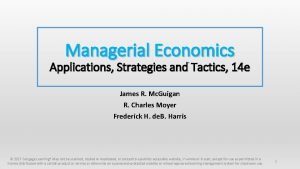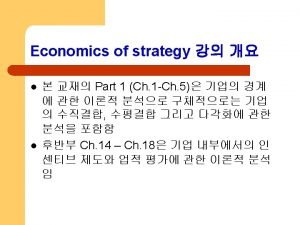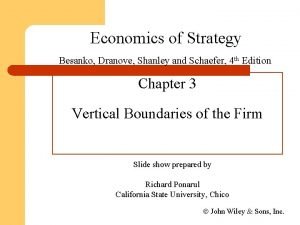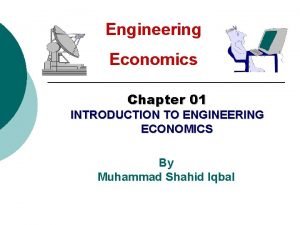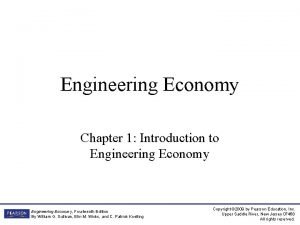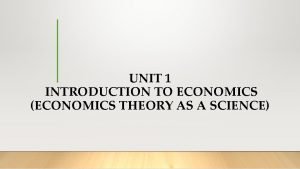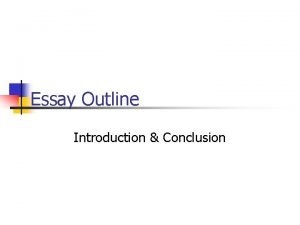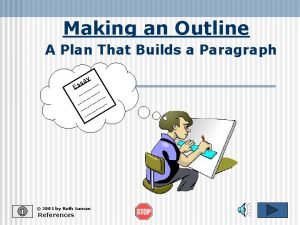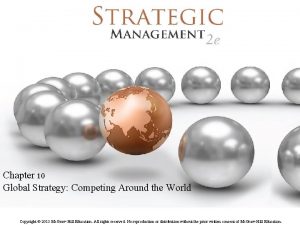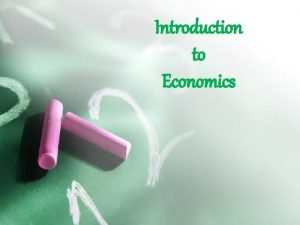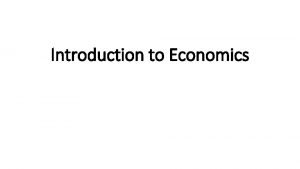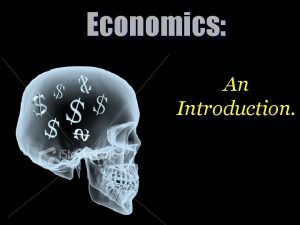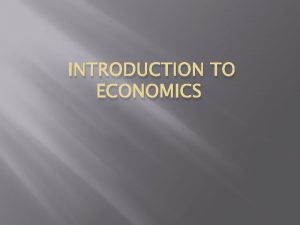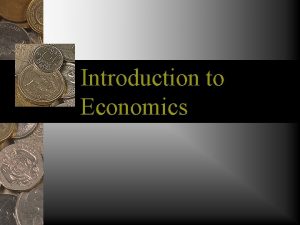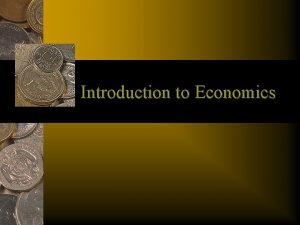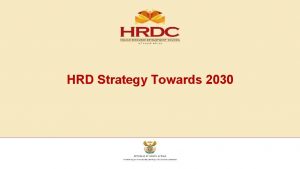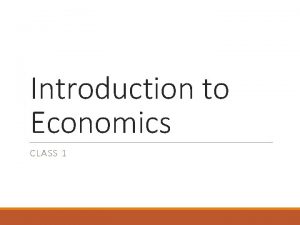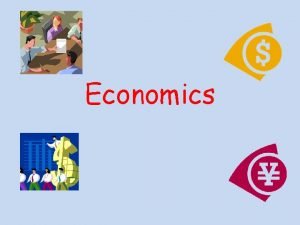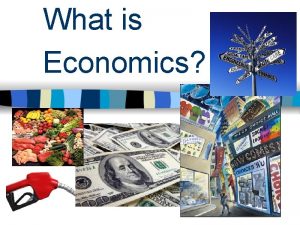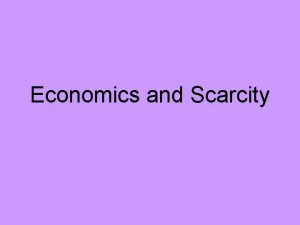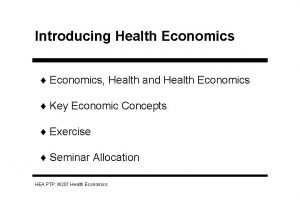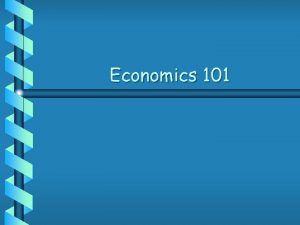ECONOMICS OF STRATEGY INTRODUCTION CLASS OUTLINE Class 1
























- Slides: 24

ECONOMICS OF STRATEGY INTRODUCTION

CLASS OUTLINE Class 1 – Introduction Class 2 – The Horizontal Boundaries of the Firm Class 3 – The Vertical Boundaries of the Firm Class 4 – Competitors and Competition Class 5 – Entry and Exit Class 6 – Industry Analysis Class 7 – Strategic Positioning Class 8 – Sustaining Competitive Advantage Class 9 – Performance Measures and Incentives Class 10 – Environment Power and Culture Class 11 – Individual Presentations

SUCCESS IN THIS CLASS • Assigned Readings have to be completed. • 80% attendance has to be met. • Short notes, and self study is required. • Participation in class room discussions is necessary. • Participating in case studies is essential.

THE IDEA OF STRATEGY • Why Study Strategy? • Why Economics and not another field? • The Framework for strategy • Historical Perspective • Principles you need to know from Economics • Case Study

WHY STUDY STRATEGY Strategy is “The determination of the basic long term goals and objectives of an enterprise and the adoption of courses of action and the allocation of resources necessary for carrying out those goals” – Alfred Chandler (Professor of Business History) “the pattern of objectives, purposes or goals, and the major policies and plans for achieving these goals, stated in such a way to define what business the company is in or should be in and the kind of company it is or should be” – Kenneth Andrews (MBA Professor) Strategy * is revealed in terms of consistent behaviour. Which means when strategy is set then it is not easy to reverse. * defines what kind of company an enterprise is or wants to be * is fundamental to the success of an organization. The reason we study strategy * Gain a better understanding of how firms compete and organize themselves. * To develop a more secure foundation for making good strategic decisions.

WHY ECONOMICS? • We can study strategy in several different ways • • Mathematically – using math theories, and equations Psychology – focusing on motivations and behaviors Accounting – basing strategy on bottom line Political Science – How strategies change based on leadership • In Economics we study strategy by carefully identifying the following • Decision Makers –who are the active players? What decisions are fixed? • Goals – What are the decision makers trying to accomplish? Are they profit maximizing? • Choices – What actions are under consideration? What are the strategic variables? What is the time horizon? • Relationship between choices and outcomes – the mechanism in which specific decisions translate so specific outcomes. Is the mechanism complicated by uncertainty such as taste, technology, choices by other decision makers?

PRINCIPLES OF ECONOMICS Costs Time Periods Economics vs Accounting Costs Demand Supply Price Elasticity of Demand Total Revenue and Marginal Revenue Market Structures Game Theory

COSTS Fixed Costs Variable Costs Average Fixed Costs Total Costs Average Total Costs Marginal Costs

TIME PERIODS Short Run Vs Long Run Define Short Run Define Long Run What happens to costs in the short run? What happens to costs in the long run? What is the shut down point? What is the permanent exit point?

ECONOMIC VS ACCOUNTING COSTS What is the difference between economic costs vs accounting costs. What is the difference between economic profit vs accounting profit.

DEMAND SUPPLY What is the law of Demand? What is the law of Supply? What are determinants of Demand Supply? What is the equilibrium point? Price Elasticity of Demand Marginal Revenue

MARKET STRUCTURES Perfect Competition Monopoly Monopolistic Competition Oligopoly

GAME THEORY What is Game Theory? Prisoners Dilemma Nash Equilibrium

THE FRAMEWORK FOR STRATEGY 1. Boundaries of the Firm 2. Market and Competitive Analysis 3. Positioning and Dynamics 4. Internal Organization

BOUNDARIES OF THE FIRM What should the firm do? How large should it be? What businesses should it be in?

MARKET AND COMPETITIVE ANALYSIS What is the nature of the markets in which the firm competes in? What is the nature of competitive interactions among firms in those markets?

POSITIONING AND DYNAMICS How should the firm position itself to compete? What should be the basis of the firms competitive advantage? How should the firm adjust over time?

INTERNAL ORGANIZATION How should the firm organize its structure and systems internally?

HISTORICAL PERSPECTIVE – 1840’S The main factors of doing business in the 1840’s 1. Were companies big or small? 2. How would one determine where the best price for his product was going to be? 3. Who did the selling? 4. What were the communication tools used in that time? 5. What was the best way to transport your goods? 6. Were factories mechanized? 7. How easy was it for companies to raise finances?

CASE STUDY RAILWAYS In January of 2009, China started a multi billion dollar spending program to build national infrastructure. Almost 88 Billion USD to develop intercity rail lines. It is said that this would change the face of China. In the 1900’s the U. S Government spent a lot of money developing their railway systems as well. They connected the west coast to the east coast – so a trip would cost less than a $100 and would be completed in 8 days. 1. What similarities would you see in terms of growth when comparing the US and China? 2. Why do you think China wants to spend so much money on rail even after the invention of the automobile. 3. What would be the pros and cons of spending so much money and developing a rail network. 4. Should Sri-Lanka follow suit and develop our own rail network?

HISTORICAL PERSPECTIVE 1910 • Business changed greatly from 1840 to 1910. • It changed because of new infrastructure like railways • Also it changed because of new technologies • Mass Production Technologies (Henry Ford’s Model T – 1913) • The development of the steel industry – the Bessemer process • Large companies were formed – monopolies occurred frequently • Standard Oil (Rockefeller), US Steel (JP Morgam, Andrew Carnegie), AT&T (Alexander Graham Bell) • Communication was faster, transportation was faster. • Many firms became vertically and horizontally integrated.

HISTORICAL PERSPECTIVE – 1990 TO TODAY • Modern Infrastructure • Transport • Telecommunications • Finance • Production Technology • Governments • Specialized firms now can achieve economies of scale • Global Markets

CLASS PERSPECTIVE – THE FUTURE What do you think will happen to the following in the next 50 years 1. Transport 2. Communications 3. Finance 4. Governments and stability 5. Needs and Wants

CASE STUDY PEPSI COLA In 1931 Pepsi Cola was in a desperate situation. The company had entered bankruptcy for the 2 nd time in 12 years. At that time both Pepsi and Coke sold 6 ounce bottles. Pepsi decided to make a 12 ounce bottle that sold at double the price of Coke. When this was not successful the President of Pepsi decided to price the Pepsi Cola 12 ounce bottle at the same price at the 6 ounce Coca Cola bottle. 1. What do you think happened to Pepsi Cola’s Market Share and Sales Turnover? 2. 3. What Economic Principles came into play 4. 5. Why wouldn’t Coca Cola follow with a similar price cut? 1931 was during the Great Depression were products inelastic then or elastic? Why did Pepsi Cola’s accounting team allow a such a drastic reduction of margins?
 Maastricht university school of business and economics
Maastricht university school of business and economics What is mathematical economics
What is mathematical economics Example of quote sandwich
Example of quote sandwich Managerial economics applications strategy and tactics
Managerial economics applications strategy and tactics Define optimal strategy in game theory
Define optimal strategy in game theory Economics of strategy besanko
Economics of strategy besanko Economics of strategy besanko
Economics of strategy besanko Introduction to economics
Introduction to economics Introduction to engineering economics
Introduction to engineering economics Unit 1 introduction to economics
Unit 1 introduction to economics Engineering economy problems
Engineering economy problems Unit 1 introduction to economics
Unit 1 introduction to economics Introduction paragraph outline
Introduction paragraph outline 5 paragraph essay
5 paragraph essay Software engineering 1 course outline
Software engineering 1 course outline Corporate strategy and business strategy
Corporate strategy and business strategy Multidomestic strategy
Multidomestic strategy The strategy
The strategy Transnational strategy advantages
Transnational strategy advantages Aligning hr strategy with business strategy
Aligning hr strategy with business strategy Cage framework
Cage framework Crafting and executing strategy in strategic management
Crafting and executing strategy in strategic management Strategy formulation vs strategy implementation
Strategy formulation vs strategy implementation Listening
Listening Directional strategy in strategic management
Directional strategy in strategic management



